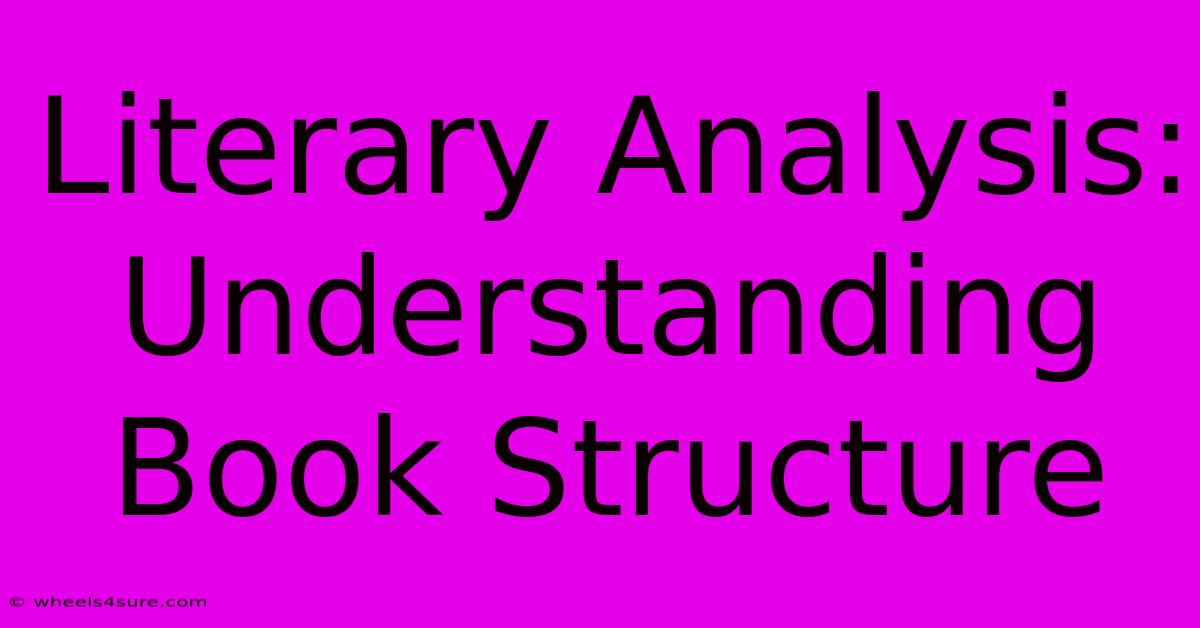Literary Analysis: Understanding Book Structure

Table of Contents
Literary Analysis: Understanding Book Structure
Analyzing literature goes beyond simply enjoying the story; it involves understanding how the story is told. A crucial aspect of this understanding lies in grasping the book's structure. The way an author organizes their narrative significantly impacts the reader's experience and the overall meaning of the text. This article delves into various structural elements and provides techniques for analyzing them.
Key Structural Elements to Analyze
Understanding a book's structure involves examining several key elements:
1. Plot Structure: The Classic Arc
The most fundamental structure is the plot. A common model is the Freytag's Pyramid, outlining the stages:
- Exposition: Introduction of setting, characters, and initial situation.
- Rising Action: Events leading to the climax, building suspense and conflict.
- Climax: The turning point of the story, the highest point of tension.
- Falling Action: Events following the climax, resolving conflicts.
- Resolution (or Denouement): The conclusion, where loose ends are tied up.
However, not all narratives adhere strictly to this model. Modern literature often experiments with non-linear narratives, jumping between timelines or perspectives, challenging the reader to piece together the story. Analyzing how the plot unfolds is crucial. Consider:
- Pacing: How quickly or slowly the events unfold.
- Suspense: How the author creates anticipation and tension.
- Foreshadowing: Hints or clues about future events.
- Flashback: Interruptions to recount past events.
2. Narrative Structure: Point of View and Voice
The narrative perspective significantly shapes the reader's understanding. Common perspectives include:
- First-person: The story is told from the "I" perspective, limiting the reader's knowledge to the narrator's experience.
- Third-person limited: The story is told from the perspective of a single character, offering a limited view.
- Third-person omniscient: The narrator has access to the thoughts and feelings of multiple characters, offering a broader perspective.
Analyzing the narrative voice involves examining the author's style, tone, and language. Is the voice formal or informal? Is it objective or subjective? How does the voice contribute to the overall meaning of the text?
3. Character Structure: Development and Relationships
The way characters are developed and interact impacts the narrative structure. Consider:
- Character Arcs: How characters change and evolve throughout the story.
- Character Relationships: How characters interact and influence each other.
- Character Motivation: The reasons behind characters' actions.
4. Setting and Theme Structure: Creating Meaning
The setting—time and place—isn't merely background; it often contributes to the narrative's meaning. Analyze how the setting influences the characters, plot, and overall themes.
Themes are the underlying ideas or messages explored in the story. The structure of the narrative often reveals these themes. Look for recurring motifs, symbols, and patterns that contribute to the overall message.
Analyzing Structure: Practical Techniques
To effectively analyze a book's structure, try these techniques:
- Create a plot outline: Map out the key events of the story, identifying the different stages of the plot.
- Identify the narrative perspective: Determine the point of view and analyze its impact on the reader's experience.
- Trace character development: Follow the evolution of key characters throughout the story.
- Analyze the use of time: Examine how the author manipulates time, using flashbacks, foreshadowing, or non-linear storytelling.
- Identify recurring motifs and symbols: Look for patterns and symbols that contribute to the themes of the story.
Conclusion: Unlocking Deeper Understanding
By understanding and analyzing a book's structure, we move beyond a surface-level reading. We gain a deeper appreciation for the author's craft, the intricacies of the narrative, and the underlying messages embedded within the text. This analytical approach unlocks a richer and more meaningful understanding of literature. So, pick up a book, and start exploring its inner workings!

Thank you for visiting our website wich cover about Literary Analysis: Understanding Book Structure. We hope the information provided has been useful to you. Feel free to contact us if you have any questions or need further assistance. See you next time and dont miss to bookmark.
Featured Posts
-
Barbie Hsus Net Worth A Case Study In Financial Success
Apr 04, 2025
-
Maxine Waters A Financial Scandal In The Making
Apr 04, 2025
-
Bccis Hidden Assets The Net Worth Puzzle
Apr 04, 2025
-
Justin Biebers Son Innocence Captured
Apr 04, 2025
-
Julia Montes Her Age Her Passion Her Story
Apr 04, 2025
